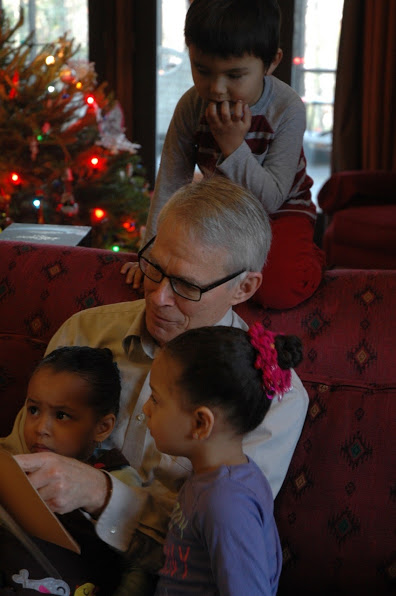Thursday
I recently came across a lovely article on the joys of reading aloud. As one who has long loved to be read to and who loves reading to others, I can testify to its observations.
Annie Hartnett records multiple instances where reading aloud enhanced her life. First, there was a woman who set up a reading group for the children of the neighborhood:
It…never felt like we were being babysat. I was keenly aware that Mrs. Cris was not being paid, and I felt she was not doing this as a favor for our parents (although, of course, I know my mother appreciated the time off); instead I was sure that Mrs. Cris was doing it because she wanted to spend time with us. She was not a teacher, not a relative; she was my first adult friend.
In her teenage years, Hartnett loved being read to in class:
Reading club fell apart somewhere in middle school, when soccer practice and clarinet lessons and trips to the mall took up all our after school time. But I still liked to be read to, and I liked to read aloud, even during the awkward, moody teenage years to come. I loved when we read plays in English class, because we’d do a read through of the whole thing. I was too shy to audition for the high school play, but I thought I was a very memorable Martha when our senior English class read Who’s Afraid of Virginia Woolf.
In college, reading aloud created bonds with a roommate:
Often, before bed, I would read Jess poems from my Norton Anthology of Modern and Contemporary Poetry. Of course, it seems a little pretentious to me now, except that I wasn’t doing it as any kind of performance. It was just something I’d learned that friends do for one another, something that brings you closer.
Reading aloud also helped Hartnett to warm up to Jess’s boyfriend in later years. Harnett read them the George Saunders short story “Sea Oak” and got the following response:
“I didn’t really like your friend until she read us the story,” Jess’s boyfriend would tell her later, and she’d pass that on to me.
“I wasn’t sure if I liked him either,” I teased.
But I have a theory on why her boyfriend liked me by the end of “Sea Oak:” in order to understand a story that is read aloud, you must listen intently. Your mind cannot wander, you must concentrate on the words. Listening to someone read out loud is like that experiment where you stare into another person’s eyes for four minutes and by the end, you’re in love with that person. It’s too intimate an experience to share with someone you dislike.
Hartnett worked for a while in a bookstore and heard many authors give readings:
Most times, when authors left the store after a reading, I felt like they were a new friend, even if I’d barely spoken to them. Every time I hand-sold one of their books afterwards, I felt a sense of personal pride, as if my distant cousin had written the book I’d recommended, as if I was keeping the royalty checks in the family.
Reading aloud also helped her marriage when it was going through a rough patch:
My husband lay on the floor underneath the loveseat where I perched…and he listened as I read. He didn’t play around on his phone. When we went to bed that night, I felt like we’d solved something. I didn’t feel so sad, and somehow life didn’t feel as meaningless. It was a way to connect that I’d forgotten about. It launched something healing for me, like a heaping serving of a comfort food. It was a bonding tool I’d been taught when I was young…
When I’m with my grandchildren, reading aloud is also my own go-to activity (see photo above). Alban, Esmé, Etta and I are all on the same plane when we are immersed in the rhythms of Dr. Seuss or Maurice Sendak. The experience never gets old.
Recently I participated in a read-aloud day at a Spring Ridge Middle School class as part of their African American History Month activities and had a similar experience. I read poems by Gwendolyn Brooks, Lucille Clifton, Langston Hughes, Quincy Troupe, and Nikki Giovanni and, except for Troupe’s “Take It to the Hoop, Magic Johnson”–which they liked at first but then found too long–they were immersed. They especially enjoyed the mix-ups in Giovanni’s “I Wrote a Good Omelet”:
I wrote a good omelet…and ate
a hot poem… after loving you
Buttoned my car…and drove my
coat home…in the rain…
after loving you
I goed on red…and stopped on
green…floating somewhere in between…
being here and being there…
after loving you
I rolled my bed…turned down
my hair…slightly
confused but…I don’t care…
Laid out my teeth…and gargled my
gown…then I stood
…and laid me down…
To sleep…
after loving you
Expect the same intense interactions when you read aloud in your adult relationships. Many Victorians, including George Eliot and George Henry Lewes, read to each other before the hearth. When Julia was going through a long labor with our oldest son, I recited to her long narrative poems, like Rime of the Ancient Mariner and Edward Lear’s The Courtship of the Yonghy-Bonghy-Bo. My colleagues Jackie and Alan Paskow, when Alan was still alive, would devote summers working through novels like War and Peace.
As I think about how reading aloud enhances intimacy, I would add “shared vulnerability” to Hartnett’s explanation. Reading literature opens up aspects of us that are normally hidden, and when we read aloud, we share that hidden side with another. Reading aloud, in other words, resembles an act of love: for a space of time, we abandon our customary defenses and make connections that are otherwise difficult to access.
